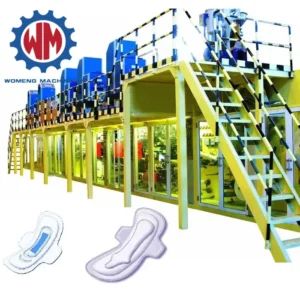A machine producing sanitary napkins typically offers various packaging options to ensure the products are conveniently packaged, stored, and distributed.
Some common packaging options for sanitary napkins include:
- Individual Wrappers: Sanitary napkins can be packaged individually in wrappers made of plastic film or paper. These wrappers provide hygiene and protection for each napkin and allow for easy distribution and disposal. Individual wrappers may also feature adhesive strips for secure closure.
- Polybags: Sanitary napkins can be packaged in polybags, which are sealed plastic bags that contain multiple napkins. Polybags offer protection against moisture, dust, and contaminants and are commonly used for bulk packaging and distribution.
- Boxed Packaging: Sanitary napkins may be packaged in cardboard boxes or cartons for retail sale. Boxed packaging typically contains multiple napkins, organized in rows or stacks, and may feature branding, product information, and tamper-evident seals for consumer convenience and product protection.
- Bundle Packs: Bundle packs contain multiple sanitary napkins bundled together with a band or wrapper. sanitary napkin machine Bundle packs are often used for economy-size or value-pack offerings, allowing consumers to purchase larger quantities of napkins at a discounted price.
- Re-closable Packaging: Some sanitary napkins are packaged in re-closable packaging, such as resealable bags or pouches. Re-closable packaging allows consumers to open and reseal the packaging for convenient storage and use, maintaining product freshness and hygiene.
- Travel Packs: Travel packs contain a smaller number of sanitary napkins, typically designed for on-the-go use or travel. These packs are compact and portable, making them convenient for carrying in purses, backpacks, or luggage.
- Biodegradable Packaging: With increasing awareness of environmental sustainability, some sanitary napkins are packaged in biodegradable or compostable materials. Biodegradable packaging options may include paper-based wrappers, cardboard boxes, or bioplastic polybags, reducing the environmental impact of packaging waste.
- Customized Packaging: Manufacturers may offer customized packaging options to meet specific customer requirements or preferences. Customized packaging may include personalized branding, labeling, or packaging designs tailored to target markets or consumer demographics.
Overall, the packaging options for sanitary napkins produced by a machine are diverse and cater to various consumer needs, preferences, and market trends. The choice of packaging depends on factors such as product specifications, branding objectives, distribution channels, and sustainability considerations.
How does the layout of a production facility impact the installation of an sanitary napkin production line?
The layout of a production facility can significantly impact the installation of a sanitary napkin production line. An efficient layout ensures smooth workflow, optimal use of space, and proper integration of equipment, which are essential for successful installation and operation of the production line. Here are some ways in which the layout of a production facility can impact the installation process:
- Space Availability: The available space in the production facility determines the size and configuration of the production line. A layout with ample space allows for easy access to machinery, material handling, and maintenance activities during installation. sanitary napkin production line Limited space may require careful planning and optimization of layout to accommodate all necessary equipment and processes.
- Workflow Efficiency: The layout of the production facility should support a logical workflow from raw material intake to finished product packaging. A well-designed layout minimizes material handling and movement between production stages, reducing downtime and improving productivity during installation and operation.
- Utility Placement: Utilities such as electricity, water supply, compressed air, and HVAC systems need to be strategically placed to support the installation and operation of the production line. The layout should ensure convenient access to utilities and proper routing of services to equipment and machinery.
- Equipment Arrangement: The layout determines the arrangement of equipment, including production machinery, conveyors, storage bins, and packaging stations. Equipment should be positioned to optimize workflow, minimize bottlenecks, and facilitate efficient material flow during installation and operation.
- Safety Considerations: Safety is a critical factor in production facility layout. The layout should incorporate designated walkways, emergency exits, safety barriers, and equipment clearances to ensure a safe working environment during installation and ongoing operation of the production line.
- Accessibility for Installation: The layout should allow sufficient space and access for installation activities, including equipment assembly, wiring, piping, and calibration. Clearances around machinery and work areas are necessary to accommodate installation personnel, tools, and materials.
- Modularity and Scalability: A flexible layout design allows for easy expansion or reconfiguration of the production line as production requirements change. Modular equipment layout and standardized components facilitate scalability and future upgrades without significant disruption to existing operations.
- Integration with Existing Infrastructure: In facilities with existing production lines or infrastructure, the layout of the new production line should integrate seamlessly with the existing layout to optimize space utilization, utilities, and workflow continuity.
Overall, the layout of a production facility plays a crucial role in the installation of a sanitary napkin production line. A well-planned layout ensures efficient use of space, supports workflow optimization, enhances safety, and facilitates the installation process, ultimately contributing to the success of the production line installation and operation.

Comments